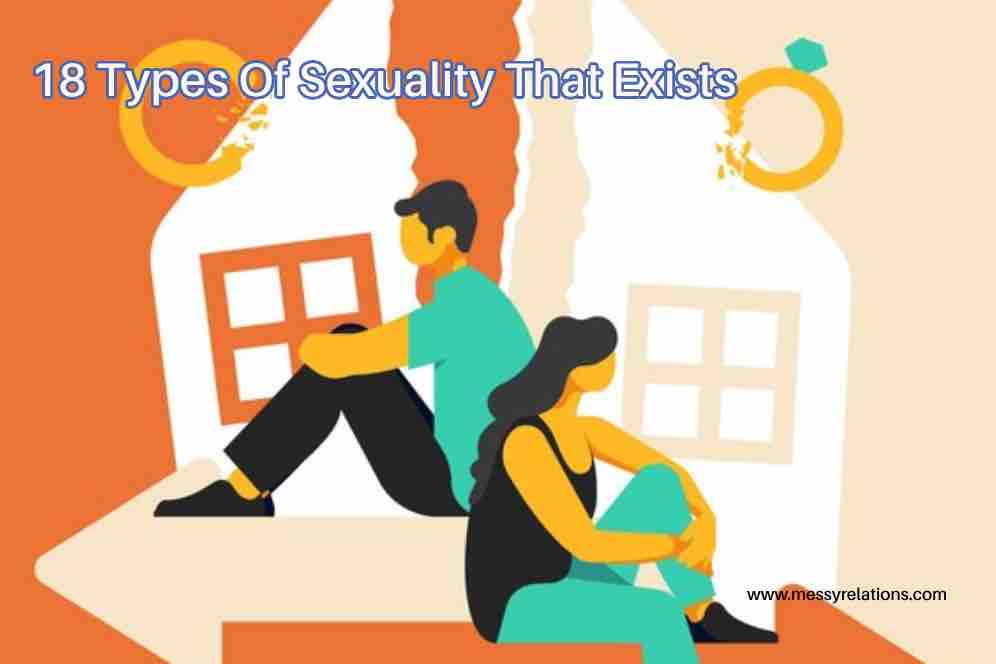Human sexuality is a complex and diverse spectrum. It encompasses a wide range of attractions, desires, and identities, all of which contribute to the rich tapestry of human experience. Recognizing and understanding the various types of sexuality is crucial for promoting inclusivity, acceptance, and respect for individuals across the globe. In this article, we will explore 18 different types of sexuality, shedding light on the beauty and diversity of human sexuality.
Types of Sexuality
There are different types of sexuality that exists. Choosing one’s sexuality is a deeply personal and significant decision that individuals may contemplate at various stages of their lives. While society’s understanding and acceptance of different sexual orientations have progressed over time, the exploration and acknowledgment of one’s own sexuality remains a complex and individual journey.
When it comes to choosing one’s sexuality, it is crucial to emphasize that sexual orientation is not a matter of choice in the traditional sense. Sexual orientation is an inherent aspect of an individual’s identity, and it emerges naturally as a result of a complex interplay of biological, genetic, hormonal, and environmental factors. It is not something that can be consciously selected or altered at will. Let’s find out about the common types that exist.
1. Heterosexuality
Heterosexuality is among types of sexuality that refers to sexual and romantic attraction between individuals of different genders. It is the most widely recognized and culturally dominant type of sexuality. It is the most commonly recognized and culturally dominant sexual orientation. In a heteronormative society, heterosexual relationships are often considered the societal norm. However, it is important to recognize that all sexual orientations, including heterosexuality, are valid and deserving of respect. Understanding and accepting the diversity of sexual orientations is crucial for promoting inclusivity and creating a more accepting world for all individuals.
2. Homosexuality
Homosexuality denotes types of sexuality that has sexual and romantic attraction between individuals of the same gender. It is an innate and natural sexual orientation. It refers to romantic or sexual attraction between individuals of the same gender
Homosexuality is not a choice or a mental disorder, but a normal variation of human sexual orientation. It is important to recognize and respect the rights and dignity of LGBTQ+ individuals, promoting equality and inclusivity. Society’s acceptance and understanding of homosexuality have evolved over time, leading to increased support for LGBTQ+ rights and equal treatment.
3. Bisexuality
Bisexuality is among types of sexuality that refers to sexual and romantic attraction to both males and females. Bisexual individuals may experience their attractions differently, and their preferences can vary over time.
Bisexuality is a sexual orientation characterized by romantic or sexual attraction to both males and females. Bisexual individuals can experience attraction to people regardless of their gender identity. Bisexuality is a valid and legitimate orientation, and it is important to understand that bisexuality does not equate to indecisiveness or promiscuity. Bisexual individuals face unique challenges, including biphobia and stereotypes that invalidate their identity. It is crucial to support and respect bisexual individuals, recognizing and celebrating the diversity of human sexual orientation.
4. Pansexuality
Pansexuality is among types of sexuality in which sexual orientation is characterized by attraction to people regardless of their gender identity or biological sex. Pansexual individuals can be attracted to individuals who identify as male, female, transgender, genderqueer, or non-binary. Pansexuality recognizes that love and attraction are not limited by traditional gender binaries. It is essential to embrace and respect pansexual individuals, creating a safe and inclusive environment for their expression and relationships. By understanding and accepting pansexuality, we promote diversity and foster a more inclusive society that celebrates love in all its forms.
Pansexuality encompasses sexual and romantic attraction regardless of gender identity or biological sex. Pansexual individuals are attracted to people’s personalities and emotional connections rather than specific gender identities.
5. Asexuality
Asexuality is among types of sexuality in which sexual orientation characterized by a lack of sexual attraction towards others. Asexual individuals may experience little to no interest in engaging in sexual activities. Asexuality is not a disorder or a phase, but a valid and intrinsic aspect of human diversity. Asexual individuals can still experience romantic and emotional connections. It is crucial to respect and validate asexuality, promoting awareness and understanding. By creating an inclusive environment, we can support asexual individuals in embracing their identity and foster a society that values diverse expressions of human sexuality.
Asexuality is the absence or lack of sexual attraction to others. Asexual individuals may still experience romantic or emotional connections and may engage in non-sexual relationships.
6. Demisexuality
Demisexuality refers to individuals who experience sexual attraction only after forming a deep emotional bond or connection with someone. Emotional intimacy is a prerequisite for sexual attraction in demisexual individuals. Demisexual individuals typically require an emotional bond or close relationship before developing sexual interest. This orientation challenges the notion that sexual attraction is solely based on physical appearance or initial chemistry. It is important to acknowledge and respect demisexuality as a valid identity, providing understanding and support to those who identify as demisexual. By recognizing and accepting demisexuality, we foster an inclusive society that acknowledges the complexity of human sexual attraction.
7. Graysexuality
Graysexuality, also known as gray-asexuality, is a sexual orientation characterized by experiencing limited or infrequent sexual attraction. Graysexual individuals may occasionally feel sexual attraction, but it is usually on a spectrum between asexuality and full sexual attraction. This orientation highlights the diversity and fluidity of human sexuality. It is crucial to recognize and validate graysexuality as a legitimate identity, offering understanding and support. By embracing graysexuality, we promote inclusivity and acceptance, creating a space where individuals can freely express their unique sexual orientations without judgment or stigma.
Graysexuality lies on the spectrum between asexuality and full sexual attraction. Graysexual individuals may experience sexual attraction infrequently, under specific circumstances, or with a lower intensity compared to others.
8. Sapiosexuality
Sapiosexuality is a sexual orientation characterized by being attracted to intelligence or intellectual stimulation. Sapiosexual individuals find intelligence and mental prowess to be the primary factor in their attraction to others, valuing stimulating conversations and intellectual compatibility. While intelligence can be an important aspect of attraction for many, sapiosexuality specifically emphasizes this quality as the primary basis for sexual interest. It is crucial to acknowledge and respect sapiosexuality as a valid sexual orientation, recognizing the diversity of factors that can contribute to individual attraction and fostering an inclusive society that embraces different forms of sexual expression.
Sapiosexuality denotes attraction based on intelligence and intellectual stimulation rather than physical characteristics or gender identity.
9. Polysexuality
Polysexuality refers to sexual and romantic attraction to multiple genders. Individuals who identify as polysexual may be attracted to specific combinations of genders or all genders.
Polysexual individuals can experience attraction to individuals who identify as male, female, and non-binary, among other gender identities. This orientation acknowledges and embraces the spectrum of gender identities beyond the binary. It is important to recognize and respect polysexuality as a valid identity, promoting inclusivity and understanding. By acknowledging and supporting polysexual individuals, we contribute to a more diverse and accepting society that values and celebrates the multitude of ways in which individuals experience and express their sexual orientation.
10. Queer
Queer is an umbrella term among types of sexuality which encompasses a wide range of non-normative sexual orientations. It is a self-identifying term used by individuals who do not conform to traditional heterosexual or cisgender norms. It serves as an umbrella term for individuals who do not conform to traditional societal norms regarding sexuality and gender. Queer embraces the fluidity, complexity, and non-binary nature of human sexuality and gender. It is a term of self-identification and empowerment for many LGBTQ+ individuals. Embracing the term queer promotes inclusivity, challenges heteronormativity, and encourages acceptance and understanding of diverse sexual orientations and gender identities within society.
11. Androgyny
Androgyny is among types of sexuality in individuals who do not exclusively identify as male or female but rather embody a combination of masculine and feminine qualities. Androgyny, the blurring of gender boundaries, challenges traditional notions of masculinity and femininity. It represents a beautiful fusion, where individuals embrace both masculine and feminine qualities, defying societal expectations. Androgynous fashion, hairstyles, and attitudes promote inclusivity, encouraging people to express themselves authentically. By embracing androgyny, we celebrate diversity and break free from restrictive gender norms. It is a powerful statement that reminds us that true self-expression knows no boundaries, inspiring us to create a world where everyone can be their authentic selves, regardless of gender.
12. Skoliosexuality
Skoliosexuality is among types of sexuality which refers to an attraction towards individuals who exist outside the binary gender spectrum. It acknowledges and celebrates the diversity of gender identities and expressions. Skoliosexual individuals are attracted to people who identify as non-binary, genderqueer, or transgender. This orientation recognizes that attraction is not limited to traditional notions of gender, but rather extends to the spectrum of identities. Skoliosexuality challenges societal norms, promoting inclusivity and acceptance. It reminds us that love and desire can transcend gender boundaries, inviting us to embrace the beauty of individuality in all its forms.
Skoliosexuality describes sexual and romantic attraction to individuals who identify as transgender, non-binary, or gender non-conforming.
13. Polyamory
Polyamory is among types of sexuality orientation where individuals can have consensual and loving relationships with multiple partners simultaneously. It challenges the traditional concept of monogamy and emphasizes open communication, trust, and ethical non-monogamy. Polyamorous individuals believe in the capacity to love and form deep connections with multiple partners simultaneously. It fosters a commitment to honesty, respect, and mutual consent among all involved. Polyamory recognizes that love is not limited or exclusive, encouraging individuals to explore and nurture multiple fulfilling relationships while prioritizing the well-being and happiness of all parties involved.
14. Monogamy
Monogamy refers to types of sexuality in which practice of having one romantic or sexual partner at a time is common. It is a prevalent relationship structure worldwide. It serves as a foundation for stability, trust, and emotional intimacy between partners. Monogamy fosters a sense of security and exclusivity, allowing couples to build a deep connection over time. This mutual dedication and loyalty can enhance communication, support, and overall relationship satisfaction. While alternative relationship styles exist, monogamy continues to be a widely practiced and valued choice for many individuals seeking lasting love and partnership.
15. Homoromantic
Homoromantic individuals experience distinct types of sexuality in which romantic attraction is exclusively to individuals of the same gender, without the presence of sexual attraction. It acknowledges that while someone may not necessarily be sexually attracted to individuals of the same gender, they still develop deep emotional connections and romantic feelings towards them. Homoromantic relationships are founded on love, affection, and emotional intimacy, and can be as fulfilling and meaningful as any other romantic relationship. Embracing and understanding homoromanticism is vital for creating an inclusive society that respects and supports diverse forms of love and attraction.
16. Heteroromantic
Heteroromantic individuals experience romantic attraction exclusively to individuals of a different gender, without the presence of sexual attraction. It acknowledges that while someone may not necessarily be sexually attracted to individuals of the opposite gender, they still develop deep emotional connections and romantic feelings towards them. Heteroromantic relationships are founded on love, affection, and emotional intimacy, and can be as fulfilling and meaningful as any other romantic relationship. Recognizing and accepting heteroromanticism is crucial for promoting inclusivity and understanding in society, embracing diverse forms of love and attraction.
17. Panromantic
Panromantic refers to types of sexuality favouring individuals who experience romantic attraction towards people regardless of their gender or gender identity. Panromantic individuals are open to forming emotional connections and romantic relationships with individuals of any gender. They embrace the idea that love and attraction transcend traditional gender boundaries. Panromantic relationships prioritize emotional connection, compatibility, and shared values rather than focusing solely on gender. By recognizing and validating panromanticism, we foster inclusivity, celebrate diversity, and promote a society where individuals can freely explore and express their romantic attractions beyond the confines of gender norms.
Panromantic individuals experience romantic attraction regardless of gender identity or biological sex.
18. Questioning
Questioning individuals are those who are uncertain or exploring their own sexuality. They may be in the process of discovering and understanding their sexual orientation or gender identity. Questioning individuals often experience a range of emotions and may seek information, support, and self-reflection to gain clarity about their attractions and identity. It is important to create a safe and accepting environment for questioning individuals, providing them with resources and a non-judgmental space to explore their feelings and discover their authentic selves. Respect and understanding are crucial when engaging with questioning individuals, allowing them the time and space to navigate their own journey of self-discovery.
Understanding the various types of sexuality is essential for fostering a more inclusive and accepting society. Recognizing and respecting diverse sexual orientations is crucial for promoting equal rights, reducing discrimination, and ensuring that every individual can embrace their true selves without fear or judgment. By celebrating the richness and diversity of human sexuality, we can create a world that embraces and celebrates the beautiful tapestry of identities and experiences that make us who we are. Let us continue to learn, grow, and support one another in our journey toward acceptance and inclusivity.
How can you choose sexuality?
The process of choosing sexuality can refer to the journey of self-discovery and self-acceptance that individuals undertake as they come to understand and embrace their own sexual orientation. It involves acknowledging and understanding one’s attractions, desires, and emotional connections towards others. This process can be influenced by personal experiences, interactions, and introspection, as well as societal norms and cultural influences.
Choosing one’s sexuality requires a supportive and inclusive environment that encourages open-mindedness, acceptance, and respect for individual differences. It is important to create spaces where individuals feel safe to explore and express their authentic selves without fear of judgment or discrimination. Education and awareness play a vital role in fostering understanding and empathy, challenging stereotypes, and debunking myths surrounding various sexual orientations.
It is essential to recognize that each individual’s journey in choosing their sexuality is unique. Some individuals may have a clear understanding of their sexual orientation from an early age, while others may take time to explore and navigate their feelings and attractions. It is important to allow individuals the freedom to define and embrace their own identities, without imposing societal expectations or norms.
Choosing one’s sexuality is a deeply personal decision that should be guided by self-reflection, self-acceptance, and an understanding that one’s sexual orientation is a valid and legitimate part of their identity. It is crucial to create a society that celebrates diversity and supports individuals in their journey of self-discovery, ensuring that everyone has the opportunity to live authentically and without fear of discrimination or prejudice.
While the notion of choosing one’s sexuality may be better understood as the process of self-discovery and self-acceptance, it remains an individual’s prerogative to explore and understand their own sexual orientation. Society has a responsibility to foster inclusive and accepting environments that empower individuals to embrace their authentic selves and celebrate the diverse range of sexual orientations that exist. By doing so, we can create a world where everyone can live with dignity, respect, and equality, regardless of their sexual orientation.




